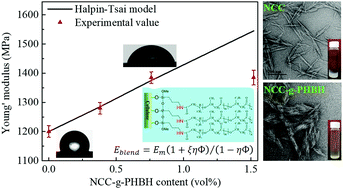当前位置:
X-MOL 学术
›
New J. Chem.
›
论文详情
Our official English website, www.x-mol.net, welcomes your
feedback! (Note: you will need to create a separate account there.)
Effects of modified nanocrystalline cellulose on the hydrophilicity, crystallization and mechanical behaviors of poly(3-hydroxybutyrate-co-3-hydroxyhexanoate)†
New Journal of Chemistry ( IF 2.7 ) Pub Date : 2018-06-07 00:00:00 , DOI: 10.1039/c8nj02012d Pengwu Xu 1, 2, 3, 4, 5 , Ying Cao 1, 2, 3, 4, 5 , Baogou Wu 1, 2, 3, 4, 5 , Piming Ma 1, 2, 3, 4, 5 , Weifu Dong 1, 2, 3, 4, 5 , Huiyu Bai 1, 2, 3, 4, 5 , Hongji Zhang 1, 2, 3, 4, 5 , Han Zhu 1, 2, 3, 4, 5 , Mingqing Chen 1, 2, 3, 4, 5
New Journal of Chemistry ( IF 2.7 ) Pub Date : 2018-06-07 00:00:00 , DOI: 10.1039/c8nj02012d Pengwu Xu 1, 2, 3, 4, 5 , Ying Cao 1, 2, 3, 4, 5 , Baogou Wu 1, 2, 3, 4, 5 , Piming Ma 1, 2, 3, 4, 5 , Weifu Dong 1, 2, 3, 4, 5 , Huiyu Bai 1, 2, 3, 4, 5 , Hongji Zhang 1, 2, 3, 4, 5 , Han Zhu 1, 2, 3, 4, 5 , Mingqing Chen 1, 2, 3, 4, 5
Affiliation

|
Fine dispersion of nanocrystalline cellulose (NCC) in a bacterially synthesized poly(3-hydroxybutyrate-co-3-hydroxyhexanoate) (PHBH) matrix is challenging due to their incompatibility. To improve their compatibility, NCC was first grafted with PHBH, marked as NCC-g-PHBH, using (3-aminopropyl)triethoxysilane (APES) as a coupling agent, leading to a grafting degree of ∼25 wt%. The grafting mechanism and the mechanical and crystallization behaviors of the PHBH/NCC-g-PHBH blends, prepared via solution casting, were systematically investigated. The NCC was uniformly dispersed in the PHBH matrix after grafting with PHBH. As a consequence, the mechanical and crystallization properties of the PHBH were greatly improved in the presence of the NCC-g-PHBH. With the addition of 1.0 wt% NCC-g-PHBH, the Young's modulus of the PHBH/NCC-g-PHBH blend was increased by 15%, which is further evaluated by the Halpin–Tsai model, while the surface contact angles decreased by 30°. Furthermore, the presence of NCC-g-PHBH copolymers greatly increased the nuclei density and decreased the spherulite size of PHBH without changing the crystal structures. Therefore, this work provided a novel route to prepare fully biodegradable and bio-based PHBH nanocomposites, which may broaden the application range of PHBH.
中文翻译:

上的亲水性,结晶改性纳米晶体纤维素的效果和聚(3-羟基丁酸酯的力学行为共-3-羟基己酸酯)†
在细菌合成的多纳米晶体纤维素(NCC)的精细分散体(3-羟基丁酸酯共-3-羟基己酸酯)(PHBH)矩阵是具有挑战性的,因为它们不兼容。为了提高它们的相容性,首先使用(3-氨基丙基)三乙氧基硅烷(APES)作为偶联剂,将NCC与PHBH接枝,标记为NCC- g -PHBH,接枝度约为25 wt%。通过以下方法制备的PHBH / NCC- g -PHBH共混物的接枝机理以及机械和结晶行为溶液浇铸,进行了系统的研究。用PHBH接枝后,NCC均匀分散在PHBH基质中。结果,在存在NCC- g -PHBH的情况下,PHBH的机械性能和结晶性能得到了极大的改善。通过添加1.0 wt%的NCC- g -PHBH,PHBH / NCC- g -PHBH共混物的杨氏模量增加了15%,这由Halpin-Tsai模型进一步评估,而表面接触角减小了30°。此外,NCC- g的存在-PHBH共聚物在不改变晶体结构的情况下极大地增加了PHBH的核密度并减小了球晶尺寸。因此,这项工作为制备完全可生物降解的基于生物的PHBH纳米复合材料提供了一条新颖的途径,这可能会拓宽PHBH的应用范围。
更新日期:2018-06-07
中文翻译:

上的亲水性,结晶改性纳米晶体纤维素的效果和聚(3-羟基丁酸酯的力学行为共-3-羟基己酸酯)†
在细菌合成的多纳米晶体纤维素(NCC)的精细分散体(3-羟基丁酸酯共-3-羟基己酸酯)(PHBH)矩阵是具有挑战性的,因为它们不兼容。为了提高它们的相容性,首先使用(3-氨基丙基)三乙氧基硅烷(APES)作为偶联剂,将NCC与PHBH接枝,标记为NCC- g -PHBH,接枝度约为25 wt%。通过以下方法制备的PHBH / NCC- g -PHBH共混物的接枝机理以及机械和结晶行为溶液浇铸,进行了系统的研究。用PHBH接枝后,NCC均匀分散在PHBH基质中。结果,在存在NCC- g -PHBH的情况下,PHBH的机械性能和结晶性能得到了极大的改善。通过添加1.0 wt%的NCC- g -PHBH,PHBH / NCC- g -PHBH共混物的杨氏模量增加了15%,这由Halpin-Tsai模型进一步评估,而表面接触角减小了30°。此外,NCC- g的存在-PHBH共聚物在不改变晶体结构的情况下极大地增加了PHBH的核密度并减小了球晶尺寸。因此,这项工作为制备完全可生物降解的基于生物的PHBH纳米复合材料提供了一条新颖的途径,这可能会拓宽PHBH的应用范围。









































 京公网安备 11010802027423号
京公网安备 11010802027423号